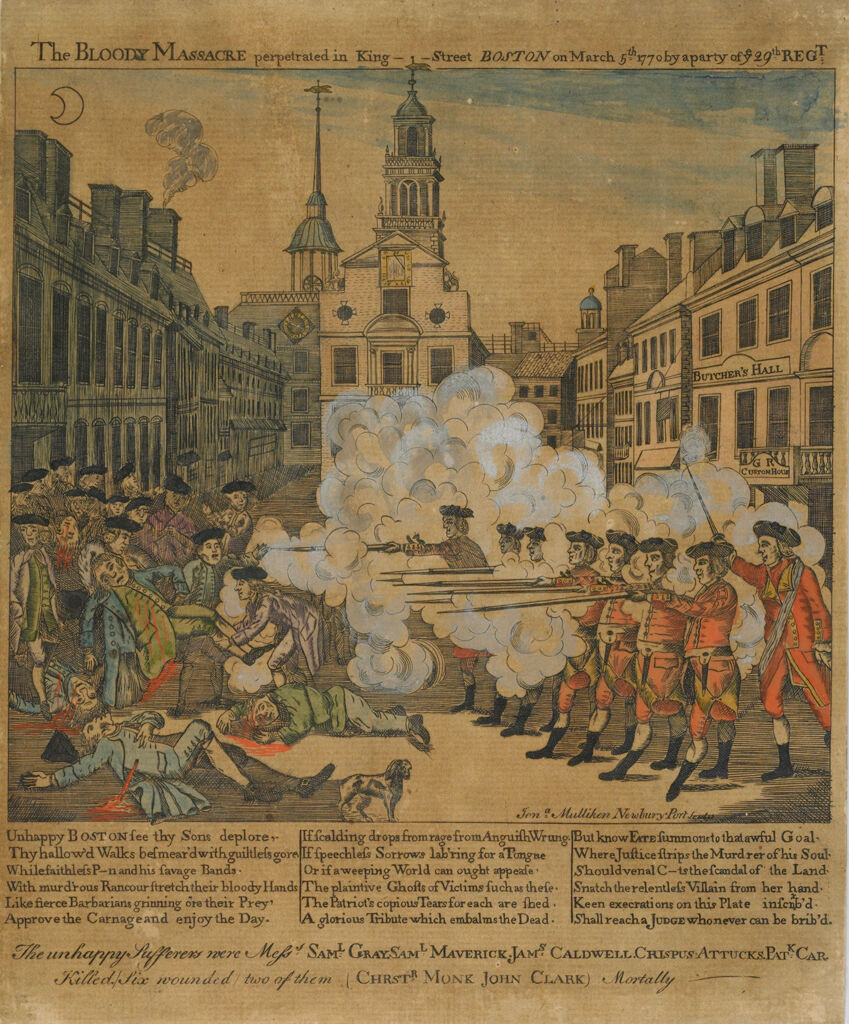Paul Revere and The Boston Massacre:
Destruction struck in the late hours of the night on March 5th, 1770. Just three weeks later, patriot and silver man, Paul Revere, would showcase what is to be known as one of the most powerful pieces of propaganda during the American Revolution, an engraving of that night.
Paul Revere (1735-1818) is a known historical figure, not only for this engraving, but for his midnight ride and participation in other war efforts. This engraving, known as “The Bloody Massacre perpetrated in King Street Boston on March 5th, 1770, by a party of the 29th Reg”[1] will impact the trajectory of the war and build upon the tensions between the Colonists and the British. He created this to make the British look bad, he was not even a witness to the massacre. 4,000 British troops imposed themselves in Boston.[2] From there, they created taxes such as the Townshend Acts, which taxed the Colonists on tea, paper, and other imports to generate revenue, causing rebellion against the British. The stance of the Colonists vastly differed from that of Great Britain, and the Colonists were trying to stand up for themselves. At this point, they had not gained their freedom, and it showed with the dictatorship Great Britain had over the colonies. The relationship between the two was already strained, and with troops barging in and then creating taxes, that strain continued to increase.
True and False:
That tension finally snapped the evening of March 5, 1770. If the only information given was based on Paul Revere’s engraving, it appears that the Colonists were just innocent bystanders being shot. However, after learning about the real events that took place, this is simply inaccurate. The Colonists were the ones who instigated the incident: “two dozen “saucy” Boston rowdies—teens, Irishmen, and sailors—began throwing icicles and oyster shells at Hugh White, a young soldier guarding the Customs House.”[3] The colonists had first provoked the British soldiers. This is not the only inaccuracy, though. For one, it happened at night, yet in the engraving, the sky is blue, indicating the daytime. Another fact that had been uncovered was that the first man killed was a person of color, yet there are only white colonists and white soldiers shown. The third fault is the lack of snow on the ground.[4] There had been over a foot of snow when the massacre occurred, yet you would never know if the events of the massacre were strictly based upon this engraving. There are also misconceptions with the British firing line, and the absurdity of a hand outstretched to stop the volley of gunfire.[5] The sign on the building that states “Butchers Hall” when that was not the actual name of the building. It was labeled as that just to get the point across that the British killed all these colonists.
The Beginning of the End:
Many things in this engraving were different than the actual events that had taken place. The Boston Massacre had a strong impact and was a turning point for the American Revolution. It ended with five fatalities and six injuries. It was so much more than just deaths and injuries. With the help of this propaganda, this catastrophic event angered the colonies and created an even bigger divide between the Colonists and the British. It depicted the oppression that colonists were looking for to fuel their anger towards the British. Trials occurred for British soldiers, some ending up in jail, and the British even revoked the Townshend Acts (they kept the tax on tea, however).[6] Changes occurred that can be seen as both positive and negative, but this massacre was such a defining moment in the war, and one of the most notable pieces of propaganda came from it.
[1] Paul Revere, The Bloody Massacre perpetrated in King Street Boston on March 5th 1770, by a party of the 29th Reg n.p., n.d.
[2] Shi, David E. America: A Narrative History (Brief Twelfth Edition) (Vol. Volume 1). 12th ed. W.W. Norton and Company, 2022, 152
[3] Shi, America: A Narrative History (Brief Twelfth Edition) (Vol. Volume 1), 152
[4] Agresto, John Art and Historical Truth: The Boston Massacre (Vol. Volume 29) (Issue 4) Journal of Communication, 1979, 170
[5] Scherer, Laurence Barrymore Not Only an American Patriot but a Craftsman Masterpiece, 1860
[6] Shi, America: A Narrative History (Brief Twelfth Edition) (Vol. Volume 1), 152
